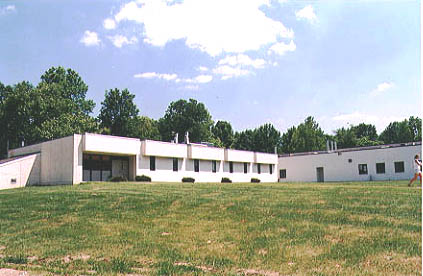Less than thirty-five miles from the National Mall in Washington, D.C., is the Smithsonian Environmental Research Center (SERC) in Edgewater, Maryland, on the Chesapeake Bay. Today, November 19 marks the anniversary of the 1987 groundbreaking for SERC’s Mathias Lab building, which was named for former U.S. Maryland Senator Charles McC. Mathias Jr. The senator was known for his efforts to protect the Chesapeake Bay from overdevelopment and pollution.

In 2014 a new, sustainable Mathias Lab opened that was the Smithsonian’s first Leadership in Energy and Environmental Design (LEED), Platinum building. The 92,000-square-foot lab contains fifteen laboratories and offices, and the original Mathias building was renovated for additional office space. The project was expected to save an estimated forty-two percent on energy costs compared to a lab not LEED certified.
SERC is home to ecological research in areas from water quality to invasive species to global change. Open to the public, the center offers visitors a quick escape from the hustle and bustle of the city on many trails, access to the water for kayak launches, and various education programs on the 2,650-acre campus.
I became acquainted with SERC when I started working at the Archives in the mid-2000s, and some of the first born-digital records I handled came from the center. These records include the SERC public website and intranet files and education program records.

The education program digital files include an impressive array of high school student scholarship on environmental research projects related to the Chesapeake Bay and its watershed from the Student Training in Aquatic Research (STAR) program. STAR was a grant-funded collaborative project between SERC and the National Oceanic and Atmospheric Administration (NOAA). The program asked area high school students to develop a project, plan field or lab work, do sampling and data analysis, and report the results. The students worked with researchers and educators and learned how to use equipment and research methods in an outdoor environment. Students also presented their findings at a symposium. This Archives collection contains Microsoft Word docs, PowerPoint files, and a video about the program.
Projects by the students include "The Effect of Surface Material on Organism Plate Settlement in the Chesapeake Bay," "The Effect of Substrate Color on the Alteration in Carapace Hue and Saturation in the Blue Crab, Callinectes sapidus," and "The Correlation Between Water Quality and Diseases in Fish."
The Archives is making sure all these digital files are properly preserved and accessible to researchers interested in areas such as SERC history, website design in the 2000s, student research on environmental topics, or other subjects that have not been considered yet.
Related Resources
- “The Smithsonian Environmental Research Center,” by Kira Sobers, The Bigger Picture, Smithsonian Institution Archives
- Smithsonian Environmental Research Center history, Smithsonian Institution Archives
- “New Mathias Lab at Environmental Research Center will have low environment impact,” Smithsonian Insider, 9 May 2011
Produced by the Smithsonian Institution Archives. For copyright questions, please see the Terms of Use.

Leave a Comment